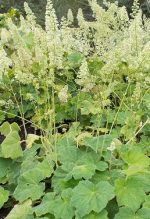 Hairy alumroot is an evergreen herbaceous perennial and a member of the saxifrage family, Saxifragaceae, that also includes tiarella, bergenia, and astilbe. It is native to Southeast from Virginia to Georgia west to Arkansas and Missouri where it grows on rocky outcrops in open woods as well as on cliffs and crevices. Growing from a fibrous root system, plants are 1-3′ tall and form a 12-18″ tall basal rosette of light green round to heart-shaped leaves up to 6″ wide with soft hairs and 5-9 somewhat triangular lobes. They resemble the leaves of maples and sometimes are tinted with bronze , red, or purple. From late summer to early fall creamy , bell-shaped, 1/4″ wide flowers appear on the hairy rust colored stems of open panicles up to 3′ long. Although similar to other heuchers in many ways, hairy alumroot is more tolerant of heat and humidity and blooms much later in the season. It is drought resistant once established and is a good choice for a groundcover, woodland garden, rock garden, or wildflower garden where its attractive foliage is an asset. The genus name ,Heuchera ,honors Johann Heinrich von Heucher (1677-1747), botanist, physician and medicinal plant expert at Wittenberg University, Germany. The specific epithet, villosa, comes from the Latin word villosus meaning hairy and refers to the hairs on the leaves and stems.
Hairy alumroot is an evergreen herbaceous perennial and a member of the saxifrage family, Saxifragaceae, that also includes tiarella, bergenia, and astilbe. It is native to Southeast from Virginia to Georgia west to Arkansas and Missouri where it grows on rocky outcrops in open woods as well as on cliffs and crevices. Growing from a fibrous root system, plants are 1-3′ tall and form a 12-18″ tall basal rosette of light green round to heart-shaped leaves up to 6″ wide with soft hairs and 5-9 somewhat triangular lobes. They resemble the leaves of maples and sometimes are tinted with bronze , red, or purple. From late summer to early fall creamy , bell-shaped, 1/4″ wide flowers appear on the hairy rust colored stems of open panicles up to 3′ long. Although similar to other heuchers in many ways, hairy alumroot is more tolerant of heat and humidity and blooms much later in the season. It is drought resistant once established and is a good choice for a groundcover, woodland garden, rock garden, or wildflower garden where its attractive foliage is an asset. The genus name ,Heuchera ,honors Johann Heinrich von Heucher (1677-1747), botanist, physician and medicinal plant expert at Wittenberg University, Germany. The specific epithet, villosa, comes from the Latin word villosus meaning hairy and refers to the hairs on the leaves and stems.
Type: Evergreen herbaceous perennial
Bloom: Creamy bell shaped flowers 1/4″ wide on rust colored stems of open panicles up to 3′ long from late summer to early fall
Size: 1-3′ H x 18″ W
Light:Full sun (in the North) to part shade (in the South); need consistent moisture when grown in the sun.
Soil:Organically rich, moist, well-drained; drought resistant when established
Hardiness: Zones 6-9
Care: Mulch in winter to avoid heaving in cold climates; divide every 3-4 years.
Pests and Diseases: None of significance
Propagation: Seed, division in fall
Companion Plants: Hosta, fern, spotted deadnettle, astilbe
Outstanding Selections:
‘Caramel’ (apricot new growth turning salmon red in the fall)
‘Autumn Bride’ (light green velvety leaves)
‘Purpurea’ (purple tinted leaves)